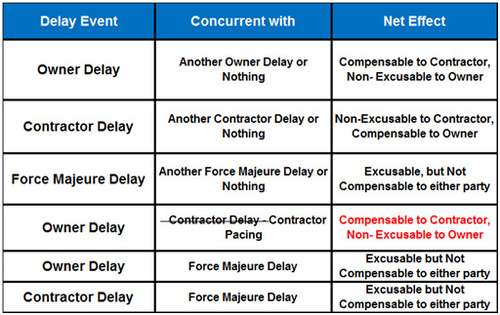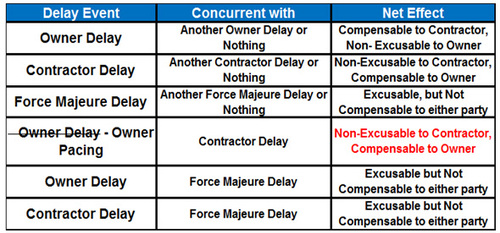PACING
Pacing
Concurrent delay occurs where another activity independent of the subject delay is also delaying the ultimate completion of the chain of activities. Pacing delay occurs when the delay in the independent activity is the result of a conscious and contemporaneous decision to pace progress against the subject delay.
The quality that distinguishes pacing from concurrent delay is the fact that while the former is a result of conscious choice by the performing party to pace the work, in the latter case, the work is involuntarily delayed by factors independent of any problems arising from the subject delay.
Pacing delay is a real-life manifestation of the principle that work durations expand to fill the time available to perform them. It can take many forms. Work can be slowed down, resulting in extended work durations, or temporarily suspended, or performed on an intermittent basis.
Whatever form it takes, the key is that it results from the performing party's reasoned decision to keep pace with another activity, which is called the parent delay, experiencing a delay.
By pacing the work, the performing party is exercising its option to reallocate its resources in a more cost effective manner in response to the changes in the schedule caused by the parent delay and thereby mitigating or avoiding the cost associated with the resource demands if one were to ‘hurry up and wait'.
In other words it is consumption of float created by the occurrence of the parent delay.
The term ‘creation' should not be interpreted to mean that total float is increased. In fact, the opposite is true. The parent delay adversely impacts the overall critical path of the project, thereby decreasing total float. What it creates (increases) is relative total float on the path of the paced activity relative to the total float on the path carrying the parent delay.
Pacing is seen by most contractors as an integral part of the detailed implementation of their means and methods. Pacing is done because it is believed that it will result in savings of money or effort to the pacing party without any penalty of net loss of time.
According to the Association for Advancement of Cost Engineering International, forensic engineering recommended practice there are two distinct circumstances to which the term, pacing delay, is often applied.
The first circumstance, often referred to as direct pacing, occurs where the duration of a schedule activity is extended due to a delay in a predecessor activity on which the progress of the subject activity is directly dependent.
An example would be the pacing of electrical conduit rough-in when the duration of metal stud installation is extended by delays. In such a case, because there is not enough work to sustain the continuous utilization of a full crew, the electrical subcontractor may order a crew size reduction, by temporarily reassigning some workers to other areas, slowing the progress.
In either case it extends the overall duration of electrical rough-in. Although this is definitely pacing, it is not considered a pacing delay because it is usually not seen as concurrent delay.
Pacing delay is the second type where the paced activity has no direct dependency on the parent delay activity, often called indirect pacing.
The fact that it shares the same time frame is a function of schedule timing as opposed to construction logic. An example of this type of pacing would be the landscaping subcontractor who demobilizes its crew and returns at a later time because critical-path work in the building has been delayed.
In this type of pacing, the sole relationship of the paced activity to the parent delay is the fact that the parent delay creates additional relative total float available for consumption by the paced activity.
The deceleration is achieved typically by reassignment or reduction of resources or entirely rescheduling the procurement of resources that would have been otherwise necessary.
It should be clear that where the pacing defense is raised in answer to the identification of a potential concurrent delay, the pacing delay is not a distinct delay event but an alternate characterization or ‘label' to describe and explain the concurrent delay event.
Therefore, the pacing issue is relevant only to the extent that concurrency of delays is an issue. If there has been no potential concurrently delays identified, pacing is irrelevant.
In some common law jurisdictions, the contractor's right to pace its work in reaction to a critical path delay is a generally accepted concept. Thus, the contractor will not be penalized for pacing its work. This is consistent with the globally accepted view that float, a shared commodity, is available for consumption on a ‘first come first served' basis.
What has not been explicitly settled by case law is the issue of compensability.
The courts' recognition of the contractors' right to pace failed to directly address the question of whether that recognition should lead to the compensability of the parent delay.
But since pacing is irrelevant without the initial assertion of concurrent delay, and since concurrent delay is irrelevant where compensability is not at issue, the general acceptance of pacing strongly suggests that the contractor's right to pace would remove the owner's defense of concurrent delay, and thereby make an otherwise non-compensable parent delay a compensable one.
Viewed in the context of the delay net effect matrix, pacing has the following effect:
Using analogous logic, the same could be said on the owner's side. If pacing is a practical use of shared float, the owner can also pace. The owner's legitimate pacing would remove the contractor's defense of concurrent delay, and thereby make an otherwise excusable contractor delay a non- excusable one.
In this case the delay net effect matrix would look like the one on the figure below.
Demonstrating Pacing
In the absence of clear legal precedence and prevailing contractual language, the community of forensic professionals developed some common-sense guidelines for determining the legitimacy of pacing delays where compensable delays are at issue in a claim. Listed in descending order of importance, they are:
1. Existence of the Parent Delay
By definition, pacing delay cannot exist by itself. It exists only in reaction to another delay which is equally or more critical or is determined to become more critical than the paced activity. This calls for the calculation of relative total float between the parent delay and the pacing delay.
Also, in cases where many different activities are being performed at the same time, it is unclear who is pacing whom. But one thing is clear: the parent delay must always precede the pacing delay. The existence of a parent delay should be a mandatory requirement in legitimizing a pacing delay.
Quantitatively, the near-critical threshold can serve as a benchmark for the need to analyze for pacing delays, just like it serves to identify concurrent delays.
2. Showing of Contemporaneous Ability to Resume Normal Pace
Pacing is not realistic unless the contractor can show that it had the ability to resume progress at a normal, ‘un-paced rate'.
Implicit in the contractor's ability to show that it could have completed the schedule activity on-time if necessary is the fact that the contractor was able to reasonably determine or reliably approximate when the parent delay would end.
Considering the typical realities of the types of projects in which delay issues arise, an exact determination is difficult. Therefore, while this should also be a required element of proof, realistically, the format and content of the analysis should not be held to the same rigorous test as the first one.
3. Evidence of Contemporaneous Intent
The case can be further strengthened by showing that the pacing was a conscious and deliberate decision that was made at the time of pacing.
Without a notice signifying contemporaneous intent to pace, the claimant can use pacing as a hindsight excuse for concurrent delay by offering after- the-fact testimony. Currently, contemporaneous notices are rare in any form, let alone specific, written notices. Therefore this should not be a strict requirement of proof.

